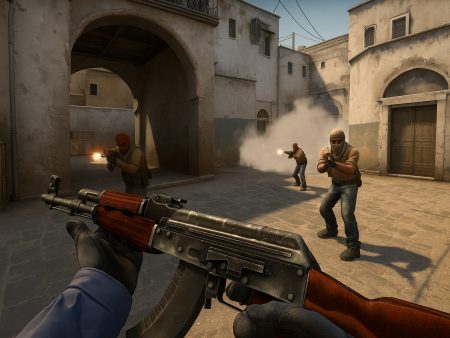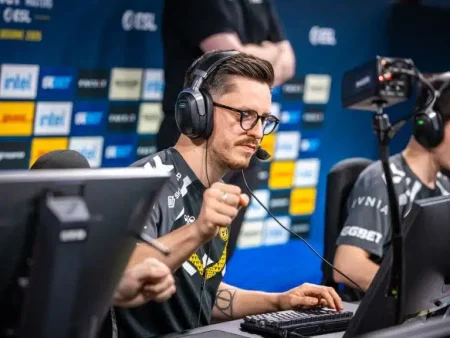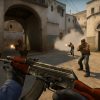Master CS2 Inferno with this in-depth guide covering map callouts, pro strategies, T & CT setups, utility lineups, and advanced tactics to dominate your ranked games.
Inferno is one of the most iconic and beloved maps in the Counter-Strike franchise. With its narrow choke points, demanding utility usage, and team-heavy dynamics, Inferno requires not just sharp aim, but impeccable communication and timing. Whether you’re a new player learning the ropes or a seasoned veteran looking to up your strategic game, this guide will walk you through every critical aspect of Inferno — from map callouts to advanced tactics, and from utility lineups to pro-level strategies.
Introduction to Inferno in CS2

What Makes Inferno Unique?
Inferno stands apart from other CS2 maps for a few key reasons. First, its tight and winding pathways force close-quarter combat, making shotguns and SMGs viable choices alongside the usual rifles. Secondly, it’s notorious for utility usage — if you don’t know how to smoke, molly, or flash effectively, you’re going to get locked out or overwhelmed quickly.
Banana control, for instance, is one of the most hotly contested parts of the map. It’s not just about pushing or defending — it’s about gaining control early with smokes and molotovs, forcing the enemy to reposition or expend their utility. This constant tug-of-war makes Inferno incredibly dynamic.
What’s more, the map is designed in a way that encourages mid-round rotation. Unlike some maps where rushing can pay off, Inferno rewards patient, coordinated play. Teams that excel on Inferno typically showcase great synergy, clear communication, and well-rehearsed utility lineups. You can’t just win by brute force — you have to outthink your opponents.
Historical Significance of Inferno in Counter-Strike Series
Inferno has a deep-rooted history in the Counter-Strike universe. It first appeared in Counter-Strike 1.1 and has been reimagined several times through CS: Source, CS:GO, and now CS2. It’s the battlefield of countless legendary matches — think back to Fnatic vs. Luminosity in 2016, or Astralis’ dominance during their prime using flawless Inferno setups.
Its visual upgrades over the years have kept it fresh, but the soul of the map remains the same: strategic, balanced, and punishing if misplayed. Because of its longstanding presence in competitive play, Inferno has become a proving ground for aspiring players and a true test of team cohesion.
Overview of Inferno Map Layout

Terrorist Side (T-side) Key Areas
On the T-side, players spawn near the bottom of the map and have access to two main paths: through T Ramp and Banana towards B, and Mid and Second Mid toward A. Each path has crucial sub-areas that can be leveraged for control or staging a push:
- T Ramp: The initial zone to peek Banana.
- Second Mid: Leads into Apartments, Boiler, and Short.
- Alt Mid: An alternate route for map control and apartment presence.
- Apps (Apartments): Offers a potential entry into A site via Balcony or Short.
- Banana: Leads directly to B, but is often highly contested by CTs with early utility.
- Mid: Splits into Short and Long, which are both key for A site attacks.
Understanding these areas is the first step to mastering T-side Inferno. Knowing when and how to gain control over Banana or Mid is essential for opening up the map and creating strategic options.
Counter-Terrorist Side (CT-side) Key Areas

CTs spawn closer to both bombsites, with a focus on defensive positioning and map control denial. The key areas include:
- CT Spawn: The central point connecting both sites.
- Arch and Library: Critical for holding Long A and rotating.
- Pit and Graveyard: Defensive A-site strongholds.
- Construction and Coffins: Defensive B positions with cover.
- Banana Control: Arguably the most critical part of early-round CT strategy.
Good CT players know how to control space without overextending. Especially on Inferno, wasting utility or pushing recklessly will often cost rounds. Instead, CTs rely on timed utility and smart crossfires to maintain dominance over key chokepoints like Banana and Mid.
Complete Inferno Callouts Guide
Top Callouts for A Site
The A bombsite is a maze of corners, levels, and vertical angles. Mastering callouts here is essential for fast communication, especially during fast executes or retake scenarios. Key A site callouts include:
- Pit: A tucked-in position below Balcony; very strong for post-plant.
- Graveyard: Next to Pit; players often hide here during executes.
- Balcony: Exit from Apartments overlooking Pit.
- Default Plant: The usual plant spot near the box on site.
- Truck Side (Short): The short path from Mid into A.
- Long: Entry point near Library; crucial for split pushes.
- Mini Pit: Small cubby between Pit and Site.
Knowing and using these callouts not only improves your team coordination but can also help with utility usage — like mollying Pit or flashing over Balcony.
Top Callouts for B Site
B Site is simpler in layout but highly technical in defense. Holding B is all about using utility to slow down or deny T entries. Key callouts include:
- Coffins: The curved wall offering great cover.
- First Oranges / Second Oranges: Stacks of boxes on site.
- New Box (Dark): Deep corner on site; tough to clear.
- Construction: Connector between CT Spawn and B.
- Boost Corner: Near sandbags; often used early-round.
- Emo / Back Site: Back corner of site; common hiding spot.
Having these callouts ingrained in your muscle memory helps with instant comms like “One Coffins, low HP!” or “Planting behind Second Oranges.”
Mid, Banana, and Other Map Control Zones
Inferno’s mid-map zones are where most early-round skirmishes and control battles happen:
- Top Mid: Critical T position before splitting into Short or Long.
- Boiler: Entry from Apps into Mid; allows fast rotations.
- Alt Mid: Offers deceptive map presence.
- Banana: Long corridor toward B; heavily utility-based.
- Logs: Right side of Banana; common early hide spot.
- Car: Early peek angle for CTs.
- Sandbags: Banana hold position, often mollied or spammed.
Mastering these zones is what separates good teams from great ones. It’s not just about winning a duel — it’s about when and where to take that duel.
T-Side Strategies on Inferno
Default Setup and Map Control
On Inferno, a strong T-side often begins with a structured default setup. This means your team spreads out to control key areas, gather info, and burn CT utility early. A solid default typically places:
- 1-2 players Banana to contest or take control.
- 2-3 players in Mid/Alt Mid to pressure A and control Apartments.
- 1 player watching T ramp or Second Mid for flanks.
The goal here is not to rush into a site, but rather to gather information and force the CTs to reveal their positions. The Banana players should use utility carefully — smoking CT’s deep Banana smoke, mollying car or sandbags, and flashing into Banana to force CTs back.
Meanwhile, Mid control can open up Apps and Short, which lets your team threaten A splits. If the CTs over-rotate or lose utility, that’s your green light for a fast site exec or a well-timed fake.
Playing a default gives your team map presence — the CTs can’t be sure where you’re heading, which forces them into passive, often weaker setups.
Executing an A-Site Take
An A-site hit on Inferno can be executed in several ways: a fast rush, a late split, or a set play involving smokes and molotovs. The most effective way is usually a Short and Long split, coming from Mid and Apps simultaneously.
For this:
- Smoke Arch and Library to block vision from Long.
- Molotov Pit and Graveyard to force out defenders.
- Flash over Balcony for the player jumping out from Apartments.
- Send one or two players through Short, timing with the Apps push.
Timing and spacing are everything. If players arrive at different times or utility is mistimed, you’ll be picked off easily. Ideally, you want to overwhelm A with 3+ players from multiple directions, forcing CTs into awkward fights or falling back.
Post-plant, take Pit, Short, and Site control. These give you crossfire opportunities and allow easier control of CT retake routes.
Executing a B-Site Take
B is notoriously hard to take if the CTs still have utility — especially molotovs and smokes. That’s why early Banana control is key. Once you’ve forced back CTs or baited out smokes, you can prepare for a B execute.
A standard B take often uses:
- CT smoke to block off rotation.
- Coffins smoke to deny vision from site defenders.
- New Box molly to flush out common hiding spots.
- Flashes over wall to blind site players.
Sending in 3 players to enter and 2 to support with flashes and trades is ideal. After-plant, control Construction and Banana for post-plant angles. Keep an eye on flankers from T ramp or CT trying to retake from Banana.
Sometimes, faking B and then wrapping A through CT can win rounds — especially if the defenders overrotate.
Late-Round Rotations and Fakes
A key skill on Inferno is knowing when to rotate or commit to a fake. If you’ve taken control of Banana but haven’t pushed into B, a well-sold fake with utility can pull rotations from A. Then, quickly shift to the other site with numbers advantage.
Smart teams:
- Use one player to throw fake utility while the rest rotate.
- Walk between sites to avoid giving audio cues.
- Watch for info pushes from CTs trying to confirm your location.
A well-timed fake can win you the round before the fight even begins.
CT-Side Strategies on Inferno
Standard CT Setup
On the CT side, your typical round starts with a 2-3 split — 2 B players and 3 A players. This may shift depending on early Banana control. Early-round priorities include:
- Banana control using molotovs and smoke.
- A apps presence with one player watching or holding from Pit.
- Mid control denial with occasional short peeks or boosted angles.
Your team should prioritize utility conservation. Don’t burn all your smokes in the first 20 seconds. Instead, play to delay, deny, and get info through sound cues.
Also, use crossfires effectively. Pit and Site on A, or Coffins and First Oranges on B, are classic setups for shutting down a rush.
Holding A Site Like a Pro
A site is all about layered defense. The most effective setups involve:
- 1 player in Pit or Graveyard.
- 1 on Site, ideally near Default or Mini Pit.
- 1 playing Arch or Library, ready to rotate.
The key here is survivability and trading. Don’t die early — delay, get one kill if possible, and fall back. If you hear an Apps push, your player in Pit should call it and stay alive while support rotates or molotovs Boiler.
Avoid overcommitting. One of the biggest mistakes CTs make is aggressing too much on A. Holding strong angles and calling for help is often better than trying to duel three Ts alone.
Locking Down B Site with Utility
B is utility-heavy. If you don’t use nades correctly, Ts will overwhelm you in seconds. Early round, use:
- Molotov for Logs or Sandbags.
- Smoke for T Ramp or Bottom Banana.
- HE for delayed Banana push.
Your B players should work together — one peeks while the other holds. After you expend your initial nades, fall back to Site or Coffins. Keep one smoke for the hit. That single smoke can buy time for a rotate and save the round.
You can also boost on Second Oranges or Dark for off-angles, catching Ts off guard. Remember, playing B is about delaying, not necessarily holding the push alone.
Adapting to Aggressive T Plays
Sometimes the Ts go fast — and you need to respond quickly. Aggressive T plays can catch you off guard, especially with mid-rushes or B splits. Counter this with:
- Early molotovs and counter-flashes.
- Passive setups after taking initial damage.
- Quick rotates through CT Spawn or Arch.
Make sure your team is always communicating. If B sees 3-4 players, A must prepare for the rotate and either hold safe or push for map info (like taking Mid control or Apps).
You can also counter-aggress on CT side. Pushing down Banana with 3 players and a flash, or taking Alt Mid control early, can disrupt the T’s default and force them into reactive play.
Utility Usage and Lineups
Must-Know Smokes
Inferno is a map that lives and dies by smokes. Without proper smoke lineups, you’re either exposing yourself to crossfire or giving the enemy free vision. Here are the essential smokes every player should know:
- CT Spawn Smoke (B Site) – Used for B executions to block CT rotation vision.
- Coffins Smoke – Cuts off the B site player watching Banana or New Box.
- Library and Arch Smokes (A Site) – Essential for splitting A from Short.
- Moto Smoke (A Site) – Used to block off Library from Short or Site.
- Long Smoke – Used to deny AWPers watching from Pit or Library.
- Mid Smoke (CT Side) – CTs can use this to delay Mid control or mask boosts.
Practicing these smokes in an offline server or workshop map is key. Smokes should land consistently and with the right timing — too early and they fade before you push, too late and you’re entering into crosshairs.
Also, coordinate with teammates. For example, on a B hit: one player throws CT smoke, another throws Coffins, and a third mollies New Box. That kind of synchronized utility can win rounds without even firing a shot.
Effective Molotovs and Nades
Molotovs serve two primary purposes on Inferno: flushing out enemies and delaying pushes. Some of the most useful molotovs include:
- Car/Logs Molotov (Banana) – Clears early CT aggression.
- New Box Molotov (B Site) – Burns common anchor spot.
- Pit or Graveyard Molotov (A Site) – Dislodges defenders during A execs.
- Boiler Molotov – Clears the corner in Apartments before a Mid push.
- Sandbags Molotov – Deters or punishes CT Banana control.
As for grenades, well-timed HE nades at Banana or Mid can chunk enemy HP. A deep Banana HE combo can often soften Ts for easy M4 taps.
Flashbangs, too, are criminally underused in lower ranks. Learn pop flashes for:
- Mid peek from CT.
- Banana entry for Ts.
- Aps pop flash for Short push.
- Construction retake flash.
Flashbang Setups for Map Control
Flashes are your best friends on Inferno. They’re easy to line up, hard to dodge, and can change the tempo instantly. Some of the best flash setups include:
- Wall flash for Banana – Bounces over the roof; perfect for T-side Banana push.
- Arch/Library pop flash – For Mid control or wrap-around to A.
- Aps pop flashes – Blinds anyone holding Balcony or Pit.
- CT retake flash from Coffins – For reclaiming B post-plant.
Coordinate flashes with teammates. One player bounces it over, the other swings. This buddy system approach makes for incredibly effective map control.
Economy and Buy Rounds on Inferno
Managing Eco Rounds Effectively
Inferno rewards smart economy play. If you’re on an eco or half-buy round, don’t just rush and hope for a miracle. Instead, go for planned utility damage and close-range engagements.
Tips for eco rounds:
- Stack B or A and play bait setups.
- Use pistols in Apartments or Pit where tight angles favor you.
- Throw utility early to delay and disorient.
- If you’re T-side, consider rushing with flashes and Tec-9s to surprise defenders.
The goal of an eco round is to either do damage (kills, bomb plant) or force the enemy to spend money next round.
Best Buys and Equipment Prioritization
On gun rounds, you must prioritize correctly. A team full of AKs or M4s without utility is often worse than a mix of weapons with full nades. Here’s how to think about buy priorities:
- Rifles + Kevlar + 2–3 pieces of utility > Full rifles with no nades.
- Always ensure at least one smoke and flash per player.
- Support players should carry molotovs and kits.
- AWPers should have pistol backup and flashes to fall back safely.
CTs especially should always buy defuse kits — one or two per round minimum.
T-side should plan around entry frags and trade potential, so ensure the first guy in has a flash or molly, and the second is ready to trade.
Mid-Round Decision Making Based on Economy
Your team’s economy should influence your mid-round calls. For example:
- If your team’s low and you haven’t gotten picks, don’t force a rush — try for a pick or site stack.
- If you get an opening kill and the CTs are broke, expect a gamble rotation or stack.
- If you’re up 5v3 and CTs have no money, hunt them after the plant to destroy their economy.
Smart eco management leads to stringing together multiple rounds, building momentum, and controlling the game flow.
Positioning and Movement Tips
Common Angles and Off-Angles
Inferno is a map where positioning can win or lose you the round. Learning to play common and off-angles can make you less predictable and more effective.
Common angles to master:
- Pit to Short cross.
- Arch side angle with AWP.
- Banana car/headshot angle.
- Graveyard to Site peek.
Off-angles are positions that aren’t pre-aimed by most players:
- Tucked into Sandbags without peeking.
- Standing on the ledge inside Apartments.
- Coffins jump-up for elevated view.
- Boost on Second Oranges at B.
These catch opponents off guard and often give you that free first kill.
However, don’t overuse them. Smart players will check them after getting punished once.
How to Avoid Wallbangs and Spam Spots
Inferno has several pre-firing and wallbang spots that experienced players abuse. Here are a few to avoid:
- Sandbags Banana – frequently wallbanged or mollied.
- Pit corner – spammable from Short or Balcony.
- Boiler/Second Mid wall – often pre-fired.
To avoid damage:
- Keep moving when you’re repositioning.
- Don’t hold the same spot every round.
- Use your teammate’s utility to bait out spam first.
Awareness of spam angles can extend your life and give you the upper hand.
Using Sound Cues to Your Advantage
Sound is everything on Inferno. Footsteps, utility pins, scope-ins — all give away critical positioning info. Train your ears to pick up:
- Banana push sounds from T-side or CT-side.
- Scope peeks from AWPers near Long or Mid.
- Repositions in Apartments or Pit.
- Teammate footsteps to mask movement.
Likewise, use walking to conceal your pushes or fake rotate sounds to draw rotations. Throwing a smoke and running a few steps can convince the CTs to rotate — opening up the other site for a free plant.
Sound = Info = Power.
Team Play and Communication
Efficient Callout Usage
Inferno is a tight map, so comms have to be fast, specific, and consistent. Here’s how to sharpen your callouts:
- Always use location + number + action: “Two Boiler pushing Short.”
- Keep it brief during fights; go into detail only after the play.
- Learn and use universal callouts like Arch, Pit, Coffins, Balcony, etc.
- Don’t overcall or panic — calm comms save rounds.
The better your team’s comms, the less confusion and more coordination you’ll experience.
Supporting Your Teammates with Utility
Selfless play wins games. That means flashing in your entry, mollying common angles, and smoking off rotate spots — even if you’re not the one entering.
Support tactics:
- Throw anti-AWP flashes for teammates peeking Mid or Long.
- Molotov common holds like New Box or Pit before the push.
- Drop utility to teammates if they’re executing.
Play around your team’s timing and always ask what they need before a big push.
Retake and Post-Plant Communication
Post-plant rounds are won with info and teamwork. As Ts:
- Communicate where you’re holding from.
- Let others know if you’re playing for bomb sound.
- Share info if you’re low HP or have utility.
As CTs:
- Retake together, don’t isolate yourself.
- Flash for teammates before they swing.
- Call if you’re defusing or tapping.
Most importantly, don’t panic — a cool, coordinated retake often wins against rushed pushes.
Advanced Inferno Tactics
Aggressive Banana Control
Banana is arguably the most strategic zone on Inferno, and controlling it can shape the entire round. Both CTs and Ts can benefit from playing aggressive, but it requires perfect coordination and utility.
For CTs, aggressive Banana control includes:
- Double or triple nades at Logs.
- Molotov for Car to deny fast Ts.
- Flashes over the wall to blind peeking Ts.
- A player peeking off the flash or even pushing to Sandbags or Bottom Banana.
Once control is taken, CTs can:
- Leave a solo player and rotate one to A.
- Push deeper for information.
- Fall back and delay site entry with smokes.
For Ts, contesting Banana early means:
- Having two players with supportive utility.
- Using a deep smoke to deny CT vision.
- Clearing Logs, Car, and Sandbags methodically.
- Listening for utility usage to judge enemy presence.
Banana is like a chessboard — win it early, and you control the tempo of the game.
Apps and Boiler Crunch Strategies
Apartments and Boiler are often overlooked, but when used correctly, they can be the linchpin of an A site take. Here’s how to dominate them:
- Fast Apps pop with 2 players flashing Balcony.
- Boiler lurk while the rest take Mid control — creates a pincer.
- Molly Pit and Graveyard, then flood out with flashes and trades.
Apps crunches are perfect for catching passive A setups off guard. If the CTs don’t have anyone in Pit or Balcony, it’s a quick plant.
Mix in silent walks and fake nades to keep your options open. Even just threatening Boiler can pull an A rotation and open up B.
Fast A Splits with Utility Chains
A fast A split — where players come from Mid and Apps at the same time — is one of the most brutal strategies when done right.
To pull this off:
- Smoke Library and Moto.
- Flash Balcony and Pit.
- Send 2–3 players Short while 1–2 jump from Apps.
- Molly Pit and Site for full clearance.
This requires flawless timing and comms, but if your utility is on point, the defenders will either be blind, on fire, or in a terrible angle for trade fights.
It’s a high-risk, high-reward play — best used when you’ve spotted weak A setups or are trying to change tempo mid-game.
Mistakes to Avoid on Inferno
Overcommitting Utility Early
One of the most common blunders — especially in lower ranks — is burning all your utility in the first 15 seconds. This leaves you dry during critical engagements.
CTs throwing smokes and molotovs at Banana or Mid too early often get baited. Smart Ts will wait it out, then execute when your nades are gone.
Tips:
- Always hold a smoke for late-round B retake or delay.
- Don’t double-molly the same spot.
- Flash only when there’s pressure or confirmed contact.
Proper utility management wins rounds long after the timer hits 00:40.
Poor Timing on Rotations
Inferno requires smart rotations, but many players either rotate too early or too late. Here’s how to improve:
- Don’t rotate unless your teammate confirms numbers or the bomb is spotted.
- Be aware of fake utility — a single flash and smoke doesn’t always mean commitment.
- If rotating from B to A, communicate your delay so A players can buy time.
Conversely, T-side players who rotate too late after a fake often find themselves out of time, especially if utility slows them down. Always keep your eye on the clock and make decisive moves.
Not Playing Off Each Other
This is the biggest killer of teamwork. Whether you’re pushing Mid or defending B, if you’re not trading kills or baiting off one another, you’re just feeding 1v1s.
To avoid this:
- Call your push: “Flashing now, swing with me.”
- On CT, crossfire or peek off teammate contact.
- Don’t isolate — even in post-plant, play crossfire setups.
Good CS is all about synchronized movement. When your whole team acts like one unit, Inferno becomes a lot easier to win.
Practicing Inferno Effectively
Custom Maps and Training Tools
There are a ton of tools available to improve your Inferno performance outside of regular matches:
- Yprac Inferno Guide – For smokes, flashes, molotovs.
- Aim Botz or Recoil Master – To sharpen aim.
- Grenade practice servers – Let you learn pixel-perfect lineups.
Practicing utility in an offline server with infinite nades is one of the most effective ways to gain an edge.
Reviewing Demos and Pro Play
Watching your own demos or pro-level matches on Inferno helps you:
- See what went wrong in your own games.
- Learn timing, rotation, and utility usage from top teams.
- Identify bad habits like overpeeking, poor crosshair placement, or late rotations.
Check out teams like NaVi, Vitality, or G2 — they’re some of the strongest Inferno teams in the world and offer tons of strategic insights.
Building Map-Specific Muscle Memory
Lastly, Inferno demands intuitive map knowledge. You should instinctively know:
- How long it takes to rotate from A to B.
- How to clear each common angle without overexposing.
- Which positions are wallbangable or spammed.
This kind of knowledge only comes with repetition — play the map, analyze your plays, and always ask: How could I have played that smarter?
Watching Pro Teams on Inferno
Best Pro Teams on Inferno
Inferno has been home to some of the most electrifying pro matches, and watching the top teams can supercharge your own gameplay.
Top Inferno teams to watch include:
- NaVi – Known for s1mple’s clutches and team synergy.
- Vitality – Their B site holds and A executes are textbook.
- G2 Esports – Known for explosive T-side Banana plays.
- FaZe Clan – Aggressive CT setups and great retakes.
These teams not only win but often do it with style and precision.
Key Takeaways from Professional Matches
Here’s what you can learn:
- Utility timing — Pros don’t waste nades; every molly and smoke is intentional.
- Team spacing and trading — You’ll never see a pro entry alone.
- Mid-round adjustments — They constantly adapt based on info and economy.
Next time you watch a demo, don’t just admire — analyze. Pause. Ask yourself why they pushed. Why they didn’t rotate. Then apply that thinking to your own play.
Conclusion: Mastering Inferno
Inferno is one of those maps that rewards brains over brute force. You can’t just run and gun your way to victory here — you need tight coordination, smart utility usage, and total awareness of positioning and rotations.
Whether you’re fighting for Banana control or pulling off a last-second retake on A, everything hinges on your team’s communication, preparation, and execution. Learn the callouts, drill your nades, study your demos — and you’ll find yourself winning way more Inferno matches.
This guide isn’t just theory — it’s a blueprint for becoming a beast on Inferno.
FAQs
What are the most important callouts to learn on Inferno?
Start with the basics: Pit, Graveyard, Library, Arch, Banana, Coffins, and New Box. These cover 90% of all comms in fights.
How do I get better at playing Banana on Inferno?
Practice your early utility, hold angles smartly, and don’t overcommit. Work with your teammate for flashes and crossfires.
Should I always smoke mid as a CT?
Not always. Varying your smoke timing or skipping it can bait T-side utility and keep them guessing. Use it strategically.
How can I improve my utility usage on Inferno?
Use workshop maps like Yprac Inferno or practice servers. Learn lineups for smokes, mollys, and flashes. Then use them consistently and with purpose.
What’s the best way to solo queue on Inferno?
Play support roles — drop smokes, flash your entries, and anchor a site. Communicate effectively and take leadership if your team lacks coordination.












